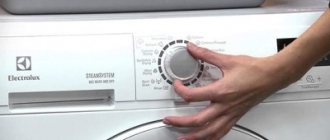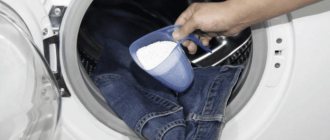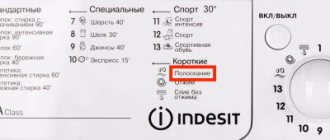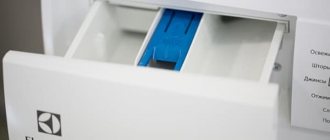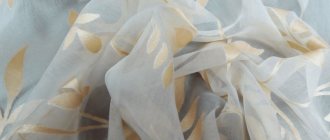Washing and clean linen is a need for every family. But each person has a different attitude towards conditioning things, because it can cause an allergic reaction or not like its smell. Typically, manufacturers indicate where to pour washing powder and where to put other detergents. But this does not always happen; in this article we will talk about where to put fabric softener in the washing machine? How to make an air conditioner for a washing machine with your own hands?
Where is the rinse aid dispenser located?
Most often, in the machine, the place where the detergents for the washing itself and for conditioning during washing are placed is a tray on the left side. Less often, the manufacturer installs it on the right. If the washing machine is designed for loading through a hatch that opens upward (vertical loading), then the tray is installed from the inside on the lid. The tray itself is divided into three compartments, different in width, and sometimes can be highlighted in different colors.
- For washing powder (marked P or B). This compartment is the deepest; all washing substances go here.
- For soaking (marking I or A). The compartment is smaller in size compared to the first one; detergents for pre-washing or soaking are poured here
- For conditioning (marking – flower). This compartment is the smallest in depth and size. It is made so that the water in the conditioner compartment of the washing machine does not wash it out during washing.
How to add when hand washing
During each treatment of products with conditioner, follow the manufacturer’s recommendations for volume and method of application. The bottle cap serves as a convenient dispenser. Softeners are used for both hand and machine washing. In the first case, proceed as follows:
- After washing clothes by hand, rinse them thoroughly.
- Then dissolve the recommended amount of product in a bowl of clean water.
- After 5-10 minutes, wring out the item and hang it to dry.
No additional rinsing is required after conditioner. It is important to maintain proportions so that the effect is not excessive.
enawowbel
vera_sugaring_amway
prouve_store
Fill rules
- 1. It is better to pour fabric softener into the washing machine while loading dirty clothes, at the same time as the product with which it will be washed. To do this, select the appropriate compartment for the air conditioner in the washing machine. If for some reason it is not filled in, then you can add it during the period when the machine is rinsing or after washing off the detergents.
- 2. Is it worth pouring conditioning liquid into the drum? In fact, you can add it, but this is done like this: when the machine has washed the main cycle, add it and set it to rinse again. You should not pour liquid into freshly washed items; just pour it into a special container designed for immersing detergent. Otherwise, soap streaks and stains may remain on the fabric.
- Do not pour it into the drum of the washing machine if the wash has just begun. So it will be washed away, and the fabrics will not receive either aroma or softness, because nothing will remain in the fibers.
- Calculate the amount of liquid correctly. There are marks in the tray indicating the maximum level, which should not be exceeded. If the amount of conditioning liquid is not enough, the smell will disappear very quickly or will be completely washed off during washing.
- Consider the consistency of the liquid. You need 2-3 times less concentrate; when pouring, you can simply dilute it.
- Wash the compartment in a timely manner, it may become clogged, otherwise the detergent will not penetrate well into the drum.
Other home uses
In addition to washing, these products are also used in other household tasks. Among them it is worth highlighting:
- washing windows, mirrors, walls, tiles and floors;
- cleaning clogged pipes;
- disinfection of various surfaces.
Windows and mirrors
A vinegar-based product is ideal for cleaning windows and mirrors. It is able to remove small stains and penetrate hard-to-reach places. At the same time, the substance does not leave streaks and disinfects the street side of the windows.
Walls, tiles, floor
When removing grease and dirt stains in the kitchen, use a product with vinegar. To clean the tiles, use a soda solution. With its help, you can remove the top layer of dirt, which will give the floor and walls a new look.
Blockages in pipes
If there are clogged pipes, many housewives recommend using borax. To do this, you need to pour the product into a washbasin or bathtub, then pour several liters of boiling water. After a few hours, the blockages will be cleared.
It is highly recommended not to use vinegar and soda for these purposes. When these substances come into contact with warm water, a solid material may form that can only be removed together with the pipes.
Surface disinfection
Cleaning various surfaces from pathogenic microorganisms is possible using a product based on boric acid. To do this, you need to use a weak solution, since borax can damage the upholstery or floors.
In addition, acetic acid is used for disinfection. It effectively destroys pests without harming surfaces. After using it, it is recommended to rinse the treated area with water to avoid an unpleasant odor in the room.
How to make your own air conditioner
Making your own fabric softener liquid is a very interesting budget-saving idea. High cost, bad scents - all this is not very pleasant, but a DIY conditioner will help you create an environmentally friendly and safe product that is equally suitable for both a child and an adult.
- Ingredients with vinegar and lavender:
- Mix dissolved acetic acid (4 liters) with twenty drops of lavender oil. Pour into a bucket and stir.
- When washing white items, 200-250 grams of liquid are used. If the capacity of the machine is not fully used, then it is enough to pour half a glass.
- If you add more, then things may simply “sit down”. The composition can be stored for up to 2 months in a cool, dark place.
Cooking recipes
Vinegar and soda
To prepare the rinse aid, you will need 1 liter of 9% table vinegar, 120 grams of soda and a glass of water. The water is heated and mixed with vinegar. Next, start adding soda, 1 teaspoon at a time. To do this, it is better to take a large container. The acetic acid will come into contact with the baking soda, causing the mixture to fizz and create a large amount of foam. That is why soda is added little by little. If you pour out all the soda at once, the reaction will be very violent.
After all the soda has dissolved in the composition, it is poured into a bottle where it will be stored. Close the lid and shake vigorously again. Add 0.5 cups of conditioner to the rinse aid compartment. When washing by hand, 1 tablespoon of product is needed for every 5 liters of water.
When rinsing with borax, you can not only make things soft, but also protect your washing machine from scale. In addition, borax destroys dust mites, fungus, and mold.
Borax is added directly to the rinse aid compartment. For one wash of 5 kg of laundry, 2 tablespoons of powder are enough.
Thick conditioner
To make a thick rinse gel, you need to mix 500 grams of warm water, 250 grams of vinegar, 200 grams of any hair conditioner. Even the cheapest option will do. Place all ingredients in the container where they will be stored and mix thoroughly. When rinsing, add 0.5 cups of product.
Epsom salt
The mouthwash prepared from it will be thick and aromatic. To do this, mix hair conditioner and Epsom salt in a 2:1 ratio. The resulting composition is added to the rinsing compartment, 1 tablespoon at a time.
For 1 liter of finished conditioner, 6-7 drops of oil are enough. After adding, the bottle must be shaken vigorously for 2-4 minutes so that the oil mixes well with the liquid.
Quick ways
If you don’t have time to make the compositions, you can add 1 tablespoon of soda or 0.5 cups of vinegar to the compartment. Any of these components will make the laundry soft, wash away excess powder and eliminate the appearance of white streaks. Acetic acid additionally disinfects laundry.
Washing machines - what are they?
Before we start figuring out where to add conditioner in a washing machine, let's look at what the detergent tray in an automatic machine is and where it is located.
In modern apartments there are two types of automatic machines. They differ in how the laundry is loaded there and are divided into models:
- with vertical loading;
- with front loading.
Important! Before you do your first wash, take a good look at the unit. This is useful to do even if the machine is new and all the documentation for it is in perfect order. It is especially important to familiarize yourself with the unit if you bought the device secondhand and the documents for it are lost.
Top loading machine
Top-loading appliances have the detergent tray at the top. Typically, manufacturers place it on the left side, but some models have this part on the right side, so don't let that confuse you.
Washing softeners: pros and cons
To understand whether you really need a laundry conditioner, analyze the advantages and disadvantages of the products and study their composition before use.
Advantages and disadvantages
Advantages:
- laundry becomes softer and more fragrant;
- the electrostatic effect is reduced;
- ironing becomes easier;
- the color of the fabric does not fade;
- things get dirty less;
- Pills appear on clothes less often.
Flaws:
- It is not recommended to use for washing children's clothes;
- poorly tolerated by people suffering from allergies or respiratory diseases;
- The most low-budget products are stuffed with harmful chemicals that can cause dangerous diseases.
Conditioner composition
The substance that underlies all air conditioners on the household chemicals market is capable of creating a special protective layer on the material. It is represented by cationic compounds, which break down and settle on tissue fibers. As a result, the material becomes softer and gets less dirty.
Rinse aids may also include:
- chloroform;
- ethanol;
- camphor;
- terpineol;
- acetic acid ester;
- limonene;
- benzyl acetate;
- A-terpineol.
Some of the listed chemical compounds belong to the 2nd class of hazard and toxicity.
How to choose?
If you haven't made up your mind yet, think about why you need fabric softener. Our theses will help you figure it out faster.
- If you are categorically against any “chemicals”, it is not necessary to use a store-bought mouthwash. You can prepare the product yourself from natural ingredients at hand (you will learn how below).
- When buying an air conditioner in a store, carefully study the composition. Do not buy products with dangerous chemical compounds. It is better to give preference to rinses with active biological components that can break down into simple substances under the influence of external factors.
- Air conditioners are concentrated and non-concentrated. In the first option, the consumption of the product will be less, which means it will be used longer.
- Ease of use. When choosing, pay attention to the packaging. The presence of a dispenser cap or a watering can will be a pleasant bonus, since it will be easier to measure the required amount of product for one use.
By following simple selection rules, you can buy a really good product that will provide high-quality results.
Examine the tray
Upon closer inspection, you will see that the tray for washing products is divided into three unequal parts. Some models also have compartments painted in different colors to make it easier for housewives to navigate. There is a large container, there is a smaller one, and there is the smallest one. Which compartment is needed for what, where to fill the air conditioner in the washing machine? Numbers or letters will tell you this.
The compartments, unless they are multi-colored, are marked:
- letters of the Latin alphabet;
- Arabic numerals;
- Roman numerals;
- one of them may have a star or a flower.
What do the letters and numbers mean?
- On one of the compartments you can see the designation A, 1 or II. This compartment is medium in size. Detergent intended for pre-washing or soaking is placed here. Of course, if you decide to do without these modes, the compartment will remain empty.
- On the largest compartment you can see the Latin letter B, Arabic numeral 2 or Roman II. This is the main container; this is where the detergent for the main wash is poured or poured. The compartment marked B, 1 or II is almost always filled - except for those cases when the detergent is placed directly inside the drum.
- Finally, the smallest compartment is marked with a star or flower. Some manufacturers designate it with the letter C; there may also be markings such as the Arabic or Roman “troika”. This is the compartment you need, where the air conditioner is poured. Sometimes it is divided into two parts - liquid starch or bleach is poured into the second container.
Important! There are models in which the softener compartment can be identified without any marking, because its internal container is removed. The design of this compartment is such that the conditioner is not washed out of the compartment during the preliminary or main wash.
If the markings are erased
What should you do if you bought a car second-hand or were given it to you by friends - you don’t have any documents or designations? The main wash compartment is quite easy to identify:
- Fill the washer with water, but do not add laundry.
- Select the main wash cycle without soaking.
- Leave the tray half open.
- Look at which of the compartments water immediately begins to flow into - this is the compartment for the main wash.
Important! The compartment where you fill the fabric softener is easy to recognize simply by its size. All model models have this compartment smaller than others.
Types of rinse aids
Modern manufacturers of household chemical products offer a large selection of air conditioners with different effects. Before purchasing, you should study the label and find out which effect of the product will be most pronounced.
Concentrates
Concentrated conditioners contain a large amount of active substances, but do not require dilution with water. They are used in their pure form. Such products save the housewife money, time and effort, since they do not need to be purchased often due to their low consumption. In addition, the bottles with concentrates are not too heavy and bulky. They won't take up much space in the bathroom.
Expert opinion
Irina. Housewife.
Ask a Question
As a rule, 1 liter of concentrated softener replaces up to 4 liters of regular product. Therefore, the higher price of the product is justified by its economical dosage.
Children's
When choosing, softeners for children's clothes require special care. It is important to make sure that the air conditioner is hypoallergenic so as not to harm the baby. Household chemical products for children's clothing are characterized by:
- absence of fragrances;
- composition without harmful chemicals;
- availability of a certificate and compliance with standards;
- using age labeling.
The quality of the product can be checked directly in the store. Shake the bottle well and evaluate the amount of foam formed on the surface. If there is a lot of it, consider other options for purchasing.
Are you unplugging your washing machine?
Oh yes! No
Balms
Rinse balms are used for washing terry towels and bathrobes, bedding, and various home textiles made of wool and synthetics. This product is suitable for baby clothes.
The advantages of the balm include:
- economical consumption;
- no odor;
- antistatic effect;
- hypoallergenic;
- presence of natural ingredients.
Eco air conditioners
The modern trend towards the use of environmentally friendly products has also affected fabric softeners. For those who are concerned about health and environmental protection, manufacturers offer products from the “Eco” series.
These are natural rinses that have a light, pleasant aroma of essential oils. They are universal, suitable for different types of fabric. The advantage of eco-softeners lies in the natural origin of their components.
When to add conditioner to the washing machine?
You have found the right compartment. Now it is important to understand when to add conditioner and other detergents to the washing machine. This should be done at the very beginning of the wash. There is no need to be afraid that the softener will get into the water during the main wash or soaking. The tray is designed in such a way that this simply cannot happen. Therefore, the washing order will be as follows:
- Turn on the car.
- Place what you are going to wash in it.
- Depending on the selected mode, place powder in one or two compartments.
- Install air conditioner.
- Set the desired mode.
Important! It may also happen that you did not intend to use the conditioner, but before finishing the wash, the thought suddenly occurred to you that it would be nice to soften the laundry. It’s okay, the softener can be placed after the main wash, before rinsing. You can do this during washing, but you must wait for the powder to dissolve in other compartments.
What is fabric softener
Conditioner is a product that complements detergents to achieve better washing results. It is added at the rinsing stage to maintain the original appearance of the products, which is lost due to the influence of:
- increased water hardness;
- machine washable;
- aggressive detergents.
Fabric softeners are also called fabric softeners or fabric softeners.
Expert opinion
Irina. Housewife.
Ask a Question
At the beginning of the last century, the first means to soften cotton fabrics were corn or olive oil diluted in water.
It turns out that fabric softeners are multifunctional. They help experienced housewives:
- wash the windows;
- clean carpets;
- clean tiles and laminate;
- remove old wallpaper from the walls.
So fabric softener will bring a lot of benefits to your household.
Is it possible to pour conditioner into a drum?
Despite the well-established opinion that you should not pour detergents into the drum of an automatic machine, sometimes you still have to do it. In particular, when it comes to air conditioning, it can be placed in a drum in the following cases:
- if after a full wash cycle you decide to rinse the laundry again;
- if you have a modern product in special packaging.
Important! This packaging is a container from which the rinse aid is released into the water in a strictly dosed manner. You can place such an air conditioner in the machine drum if you are not going to do any more washing, but only intend to rinse the laundry well.
Other detergents
Detergents that are intended for the main wash or soak can also sometimes be poured or poured directly into the drum. This is always done with activator-type machines, because there are no trays for powder.
The nuances of using an air conditioner
Getting the timing and compartment right isn't everything. In order for the air conditioner to work as efficiently as possible, you need to follow a few more important recommendations. So, you should remember about the dosage, type of product and the nuances of its dissolution.
- Dosage. If you add too much liquid, exceeding the recommended level, the product will not have time to dissolve, and the laundry will harden and become covered with white spots. Underfilling will also have a bad effect - the rinse aid will be ineffective. It is better not to experiment, but to calculate the dose according to the instructions on the package.
- Air conditioner type. The modern market offers dozens of different gels: for colored, wool, delicate fabrics, children's underwear, etc. It is important to choose the right liquid or use universal formulations.
- Compound. Concentrated rinses are often found, which are recommended to be diluted with water in a ratio of 1 to 3 before adding to the dispenser.
Another nuance concerns attentiveness. Liquid laundry detergents have similar packaging, so in a hurry, instead of conditioner, you can pour a stain remover or anti-scale mixture into the machine. The result is often disastrous. There is only one way out - to be extremely careful.
Unusual means
Manufacturers of household chemicals do not stand still and constantly offer their customers new and new detergents. Unusual means so far include:
- powders and liquids in special packaging;
- soap nuts.
Powders and liquids in special packaging are precisely designed to be placed in a drum. The packaging is a container from which the substance is dosed into the water. Moreover, such detergents can be sold both directly in containers and in large bags to which such a container is attached.
Soap nuts are becoming increasingly popular. These fruits of an exotic tree, coming from the tropics of Africa, do not cause allergies, have no odor, and cope well with any pollutants. They are placed in a drum in special bags.
Important! Bleach should not be placed in the drum - only in the special compartment!
In short, right now I’m pouring air conditioner into its special compartment, and it’s like underneath all this stuff with three compartments for calgon powder and air conditioner, those with top-loading machines should understand. But for those who don’t understand a little approximate photo of what the design is there
So, I’m obviously not going to repair it, I can’t figure it out myself, maybe it’s where it’s cracked or something, but the question is how to solve it easier, can I just pour conditioner into the drum? will the effect be the same?
Additional components
Conditioner consists of more than just surfactants. It contains many other components that determine a number of additional properties of the air conditioner. One of the most important components is silicone, which can have both a water-repellent and moisture-absorbing effect. Therefore, before purchasing this product, be sure to read the instructions about what kind of laundry it should be added to during rinsing.
For example, for towels and bathrobes it is very important to immediately restore their moisture-absorbing properties, which may have deteriorated slightly under the influence of surfactants. In addition, it is the presence of silicone that guarantees you no pilling after washing your clothes, since it very effectively smooths out all the fluff during rinsing
Of the additional components, fragrances can often be seen on the mouthwash label. It is thanks to their presence that you can get a pleasant aroma that you can enjoy not only immediately after washing, but even after the laundry has dried.
All other components: preservatives, dyes, thickeners and others are responsible only for the shelf life of the conditioner, its color, consistency, but in no way affect the condition of the laundry after its use. Therefore, the fewer components in your favorite product, the better.
Review of the best air conditioners
From the assortment of store-bought fabric softeners, according to the opinions of most housewives and young mothers, the best are considered:
- Vernel. Does not cause skin reactions. There is a separate line of products for children's items. The manufacturer also thought about people suffering from allergies and released a mouthwash - Vernel Sensitive with a gentle composition. The composition includes safe components and cationic PVA, which completely dissolve. This product is not suitable for delicate fabrics. The assortment includes a wide variety of flavors to suit every taste.
- Lenore. A low-concentrated product with an environmentally friendly composition and hypoallergenic properties. The line includes products with apple, floral and herbal scents. Some housewives claim that after washing clothes have a distinct chemical smell.
- Eared Nian. Designed for the care of children's underwear. The composition is completely environmentally friendly and safe. Lavender and aloe extract are used as fragrances.
- Kotiko. A product with a subtle and delicate aroma. The substance contains only safe components and additives. Among the shortcomings, most housewives highlight impractical packaging.
- Clean Home. Designed for the care of children's clothing. The range includes products with floral, herbal and fruity aroma.
Of course, only you decide whether to use fabric softener or not, buy the product in a store or make it yourself. When choosing a store-bought mouthwash, always pay attention to its composition and the date of manufacture on the packaging. When using both purchased and homemade conditioner, be sure to follow the rules of use and the dosage of the product per wash. With the proper approach, after washing, things will become soft and pleasant to the touch, have rich colors and smell pleasant.


